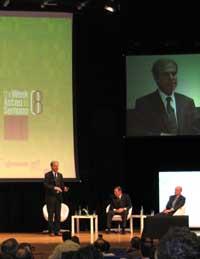A computer for poor children, technology pioneer
2008/03/01 Leturia Azkarate, Igor - Informatikaria eta ikertzaileaElhuyar Hizkuntza eta Teknologia Iturria: Elhuyar aldizkaria
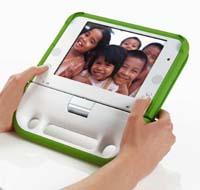
Project OLPC
Convinced that the digital rupture will only increase other differences in the future, in January 2005 they founded the One Laptop Per Child (OLPC) foundation to help reduce it. It aims to educate Third World children through the use of ICTs and technological literacy.
The project has been supported financially by companies such as AMD, eBay, Google or Red Hat. But the germ and soul of OLPC is known by the MIT (Massachusetts Institute of Technology), founder and director of Nicholas Negroponte, director of Media Lab at MIT, formed by a series of computing weights related in one way or another.
XO computer
To achieve the goal of the OLPC project it is essential that children in developing countries have access to computers and through them to the Internet. This objective focused on the design of a laptop, but not according to the usual criteria, but according to the needs of children in poor countries: light, low consumption, sustainable, with screen in sunlight that will look good... And also, cheap. The idea was that Third World governments would buy in large quantities, at least one million units in batches, and that the cost produced in those quantities was $100. Hence the project has one of its best-known aliases: Computer 100 dollars.
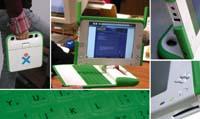
Esan eta egin, the first prototype designed for November 2005, has been evolving and improving until reaching the model called XO, currently in production phase.
From many points of view, the XO computer has very good features. On the one hand, it has a weight of only 1.5 kg and a screen of 7.5 inches of resolution of 1200 x 900 pixels. But it is not an LCD or TFT screen, but an electronic ink screen, and it looks like it is printed on paper, even outside and in sunlight. It also consumes much less than other screens. In addition, the screen can be rotated and, when closing the lid, it remains as an electronic book, without keyboard, to be able to move through the book only with arrows.
On the other hand, its consumption is very low. If conventional laptops consume 10-45 W, the OTA only needs 2 W, and less when it works as an ebook, between 0.3 and 0.8 W. With this level of consumption you can do hours or days without charging the battery. In addition, the battery supports between 2,000 and 3,000 charges, between 4 and 5 times more than normal. It also has an accessory to charge the plugged battery, prepared for high power incidents. And, if that were not enough, it can be loaded by pulling a rope; thanks to it, it can also be used where there is no electricity.
XO uses Wi-Fi to connect to the Internet. It has two antennas that must be erected to open the computer cover and that allow a greater scope than conventional Wi-Fi cards. Also, even when the computer is turned off, the Wi-Fi system works as a router and allows connection to computers of children too far from the point of connection. All consuming much less than usual Wi-Fi connections. It includes camcorder, microphone, speakers, 3 USB ports and SD card slot and is prepared for “accidents”: the keyboard is waterproof (you can throw water or land quietly, does not enter the interior) and is not as fragile as other laptops, does not break when falling to the ground.
Of course, to get this type of features at a reduced price they have had to sacrifice other things. Most of the components are not as fast or powerful as those of conventional computers: the microprocessor is from AMD, with a speed of 433 MHz and an integrated graphic controller, has a DDR memory of 256 MB and has no hard disk, but a flash memory of 1 GB.
In addition, to achieve low consumption, the XO computer has no mechanical part: it does not have hard drives, floppy drives or CD/DVD reader (this type of peripherals can be connected from USB ports). And it doesn't have a fan either, as it doesn't need it; with the speed of the processor it just heats up.
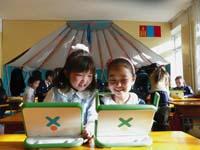
Educational objective
But as Negroponte himself has often said, OLPC is not a laptop project, but an educational project. That's why software is very important. All it has is free software, as is normal in a project for the third world. It has Linux operating system, specifically Fedo distribution. As a graphical interface it has the name of Sugar specifically designed for this project, very different from those we are used to, but very intuitive for children or for someone who first takes a computer.
It has several general software installed to learn: Internet browser, RS reader, text processor, chat program, audio and video recording and playback programs, command line terminal, drawing program, document reader, calculator... And many other educational programs, many of them games, based on the theory of constructivist teaching of Piaget: couples game, music composed and learned, games to learn to program, oscilloscope, program to measure the distance between two DGT...
In addition, many of the programs created for OTA by collaborators from around the world can be downloaded and installed very simply and every day new ones appear. And being a Linux system, you can download and install any software made for Linux.
During the last two years, pilot experiences have been carried out in several countries through the school distribution of the DGT prototypes, reaching for some months schools in countries that have acquired the production model. They say that the welcome and appreciation that children have made is perfect. It changes their lives, it opens a new world for them. They give them unimaginable uses, learning from each other.
In many villages, the arrival of the OTA has meant a real change and you can read very beautiful experiences on the net. For example, in the small village of Arahuay in Peru, the number of children who go to school is 10 times higher since the arrival of ROTA, which from early childhood began to work as peasants. And in the village of Khairat in India, they use cows flying with a dynamo to get electricity for school DGTs and prevent children from loading by hand.

Insufficient dissemination
Therefore, the qualitative assessment of the OLPC project is optimal. They have designed an excellent machine that has proven that it can perfectly meet their goals. However, the quantitative assessment of the project is not so good. The presentation of the first prototype at the Information Society Summit in Tunis in November 2005 was well received by the Heads of Government. And at the World Economic Forum in Davos in January 2006, the United Nations Development Programme supported the OLPC project. Therefore, OLPC made very positive forecasts: In 2007, 10 million units were expected to be sold and from 2008, 100 or 150 million units per year. And sales have not yet reached a million...
The reasons are many. First, the manufacture of the first definitive model has been delayed until November 2007. In addition, it serves almost double the announced. Most of the rise, however, is not due to the OLPC, but to the continued fall of the dollar in recent years. However, the rise has been rejected by some committed countries, such as China, who have begun to develop their own cheap computer programs, such as India and Venezuela.
Another of the main reasons is undoubtedly the interest of many large companies for the project. Many computer and software manufacturers who have so far not worried about poor countries have taken out their products and counteroffers so that a future market will not be carried by another. Microsoft, for example, began offering Windows and Office in three dollars last April to children from developing countries. And Intel, to compete with the OLPC, has taken out the Classmate computer, for the same users, that wants to be similar in its features, although it does not achieve it (it is more expensive, consumes ten times more, Wi-Fi has a third of the scope and does not work as a proxy…).
These two products would not be a round for the OTA, but, however, there have been several countries that have conquered, because both big companies have other things that do not have the OLPC: commercial infrastructure in many territories, preferential treatment in the media and, why not say, as scrupulous as all multinationals. Multinationals are usually experts in bribes and intoxication campaigns, and there have been too many coincidences: Conspiracy theories against OLPC (such as Brother John de Negroponte, director of US intelligence services, have been said that they can know the location of XTs via satellite and can access the contents of XTs) have led to trial in Nigeria because the XO keyboard breaks a patent and its distribution is not possible, some countries have requested the installation of Windows......
All these inconvenience and problems have led him to be forced to carry out a series of actions that he did not want to carry out the OLPC project. For example, OLPC received criticism because in the US they also have ICTs and areas with educational needs, and have finally had to sell some Xs in some of their schools. Or to fund the project, they have had to launch the Give One Get One campaign, which allows individual US and Canadian users to buy the XO computer at double price, giving away a third world child, who has sold 83,000.

Change in the technological world
In any case, both through the OTA and third-party computers, there is no doubt that advances in technological literacy for Third World children will occur thanks to the path opened by OLPC. But the situation of education in the third world is not the only thing that OLPC has managed to change, but it has also influenced the whole world of technology.
In fact, laptop manufacturers have begun to market cheap and lightweight models for developed countries. The first and best known is the Asus EVE PC, but there are also others: The Chinese Longmeng, the Nanoboos of VIA... And on desktop computers there have also begun to be less than 200 dollars in the US, distributed by large surface stores: Everex gPC (Wal-Mart), Mirus Linux PC (Sears), Shuttle KPC... The famous Macbook Air, presented by Apple in January, which is also the thinnest computer in the world that was featured in an envelope, owes much to XO. Of course, you can't compare the two, Macbook Air is much more powerful (which, worth 10 times more! ), but drink a lot from the XO sources: lightweight, lower power processor, small hard drive, no CD/DVD, no Ethernet port, etc.
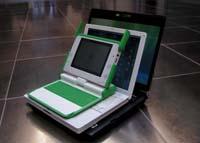
In short, the criteria used in the design of the GAC (cheap, light, low consumption) and the way to achieve it (flash memories instead of hard drives, without CD/DVD, of lower power), are undoubtedly appropriate for developed countries. Here, laptop manufacturers have paved the way so far: they have always made computers faster and faster, with more powerful disks and better graphics capabilities, but heavy and expensive. Who knows why they have done it for inertia, competition between producers, or to justify not lowering prices...
At least now, computer manufacturers have realized the power race and, at least in part, have begun to work with more practical criteria (price, weight, consumption, use and optimization of resources...). Finally, the small XO of the low OLPC has revolutionized the world of big tech companies.
More information:
http://en.wikipedia.org/wiki/One_Laptop_Per_Child
http://www.olpcnews.com
http://www.laptop.org

Gai honi buruzko eduki gehiago
Elhuyarrek garatutako teknologia



